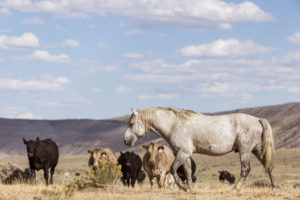For immediate release – April 18, 2012
| Contacts: | Jonathan Ratner, Western Watersheds Project, 877.746.3628 |
| Contacts: | Matthew Bishop, Western Environmental Law Center 406.324.8011 |
Forest Service agrees to remove livestock corrals that impede the pronghorn’s migration.
Cheyenne, WY– Conservationists and the US Forest Service today signed a settlement agreement that will protect a 6,000-year-old, critical migratory corridor necessary for the survival of North America’s fastest land animal, the pronghorn. The Path of the Pronghorn is the longest remaining migration of any land mammal in the lower 48 states.
Western Watersheds Project, represented by Western Environmental Law Center, had filed a lawsuit in November 2011 challenging the Forest Service’s decision to authorize the building of private livestock corrals on public lands on the Bridger-Teton National Forest. The corrals had the potential to impede pronghorn migration and block the movement of other large mammals. The agency has since withdrawn plans for future construction and fencing, and today, the agency agreed to take existing structures down.
“Though it’s unfortunate we had to go to court to convince the Forest Service that fencing for livestock corrals was bad for pronghorn, we are happy with the result,” said Jonathan Ratner, of Western Watersheds Project. He continued, “Now, the agency agrees to protect the path of the pronghorn, and we have offered to help remove the barriers and restore the migration corridor when conditions permit. “We also established an important precedent that it was illegal to build the corrals in 2006 and call them ‘temporary’ and leave them there for half a decade,” Ratner added.
The contested corrals are located at the confluence of Slate Creek and the Gros Ventre River in Wyoming. This area is a critical link in the “Path of the Pronghorn,” an annual migration corridor for the species between the Upper Green River Valley (near Pinedale) and Grand Teton National Park. Numbering only a few hundred, this dwindling herd relies on this migration corridor for its very survival. In 2008, in recognition of the importance of this corridor to the pronghorn, the Forest Service designated this area as the nation’s first wildlife migration corridor.
In addition to the impacts of the corrals on the pronghorn, the manner in which the agency made the decision to build these and other structures in the Path of the Pronghorn was problematic. “For the most part, these decisions to build were made behind closed doors, via internal ‘categorical exclusion’ decisions, and in the absence of an environmental analysis as required by law,” said Matthew Bishop, an attorney with the Western Environmental Law Center in Helena, Montana who represented Western Watersheds Project. “In the future, if the Forest Service wants to authorize new facilities and other fencing projects in the Path of the Pronghorn, it must first take a hard look at the overall, cumulative impacts to the migration corridor,” Bishop concluded.
The settlement agreement is available here:
https://www.westernlaw.org/sites/default/files/StipulationAgmt041712.pdf
###







